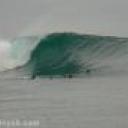Tasman Lows don't produce 'groundswells' for South Coast NSW


"Tasman lows don't produce groundswells for South Coast of NSW"... eh?
Almost everything you've written is incorrect in some way shape or form - where your evidence, other than "I've seen em all"?


OS, I've been writing comprehensive surf forecasts on Swellnet for more than fifteen years now, in which I detail the precise origins of each swell, and estimated its characteristics once it makes landfall.
Whilst I occasionally get it wrong from time to time - of which I'm always the first to point it out, and then discuss the reasons why the forecast was incorrect - I've never had anyone pull me up and accuse me of publishing false information (i.e. "You said that south swell originated from eastern Bass Strait, that's not true - it came from here instead). All of my evidence is there for you in the Forecaster Notes archives.
However, if you're going to make wild claims (as per your earlier post), you need to back it up with your own evidence.
Even better - if you see me incorrectly analyse a swell event in the future, why don't you point it out at the time? Then we can discuss it with the benefit of having real time buoy data and weather charts to verify the facts.


(note: the initial comments above were pulled from a Sydney Forecaster Notes discussion; they're better off in our forums)


Re: "It could depend on what our opinion is over what is a groundswell. It's my opinion that the term is very loosely and overly used by Swellnet."
I alternate between the terms 'windswell' and 'groundswell' depending on the characteristics of the swell, rather than its period. Sometimes I'll include 'long period', 'long range', 'short range', 'mid-range' but that's usually just to qualify or distinguish it against other swells in the same forecast period.
Windswells are weaker swells, usually quite peaky and random, and short lived, best suited to beachbreaks. Groundswells are long lined, well defined, well suited to reefs and points (obviously, dependent on direction).


8mt swell with 2mt thick lips in 1992
What month in 1992 ?


@oldsouth,
It seems like you're mixing up general statements with specific examples - which I assume refer to your local spot (in 1992 do you really think everywhere had two meter lips? Of course not, that's just your limited observation). However, I can assure you that my local won't close out or "snip off" in a 12 second 1.6 meter south swell. As long as local winds co-operated it'd It'd be four feet and off the richter.
Also, the next town north there's a beachbreak that responds well to a mix of swells in the water, it creates peaks from headland to headland, and from what I know Sydney's northern beaches likes an east swell overlaying a south swell, because without it the south swell would just close out. So all that is in direct contradiction to what you're saying.
Plus, to say that we don't get groundswells from the tip of NZ South Island is absurdly incorrect and I've no idea how you could justify it? They're rare but they happen, and almost by virtue of distance alone they arrive as groundswells. I'm curious about your definition.


MHL's network of wave buoys record 3m southerly groundswells every other week. They are a very common occurence in NSW.
And, if a swell came from "a long way past south NZ", then it'd be a S/SE or even SE swell, not S'ly.


Did you edit your post? Has a time stamp of 5:08pm yet my comment after it was several hours earlier.


Anyway, how would you classify today's swell?


What's your reasoning for calling it a windswell?


OldSouth, swell hit 13s yesterday out of the SE, mixed in with some weaker mid-period S energy.
Surfing, the SE groundswell swell was inconsistent as expected, with it being generated off New Zealand's South Island but there were great defined groundswell lines hitting the reef and shelf I surfed all morning.


Yesterday's swell wasn't "off a local weather system", it originated from a low off the SW tip of New Zealand's South Island.
That's a travel distance of approx 1,600km to the South Coast, 1,800km to Sydney, 1,900km to the Mid North Coast and 2,100km to the Gold Coast.
What is your cut-off distance for a 'windswell' to become a 'groundswell'?
And at what swell periods does a 'windswell' become a 'groundswell'?


I'd agree with OldSouth, yesterday's swell wasn't a groundswell on the south coast. I tend to think anything with a period of less than 14-15 secs as not a groundswell, just swell and if the period is less than about 10 then it's just windswell(yes, I know all swell comes from wind). Under 6 it's nothing more than windwaves(chop in other words).


Classifying a swell on period alone is fraught with difficulty.
Compare a 3m swell at 10 seconds to a 0.5m swell at 16 seconds.
Even a solid trade swell at 8 seconds is gonna kick your arse, if you're in the right (wrong) spot at the right (wrong) time.


There's no textbook consensus as to where windswell stops and groundswell begins but most agencies/companies put it between 10 seconds and 14 seconds - and in australia we tend to err toward the lower end. it's kind of pointless to specify the period exactly as a windswell doesn't instantly transform when it reaches a certain period, so a range makes more sense.
In Sydney we see many 10 second swells that meet groundswell consideration. i would've thought the south coast would be the same, however you're also talking about origin and I haven't read all the comments.


A fetch length of 1600km is windswell material?
I grew up surfing in SA on the metro beaches, where the fetch length was 50km across the gulf. THAT is a windswell source.


It's not me that's contradicting myself.
"it's good that you have waves nearby which work in wind swells and multi swell setup, that's exactly what we want"
vs.
" So it's actually bad to have a number of swells acting."
and
" I saw barrels near my place in 1992 in a swell like that which were about 8 m high with about 2 m thick lip throttling way out square." (note the plural - "barrels")
vs.
"one wave at that one spot for about 6_8 secs had that lip"
You're either bad at expressing yourself or you're just looking for an argument.


Look OldSouth, if you want to describe any surf with periods of 14 seconds or less as windswells, that's fine with me. We'll have to agree to disagree.
But so many of your other points just don't make sense, or are your personal interepretation. And that's fine - but is there any merit in debating 'em? For example:
"Tasman lows don't produce 'groundswells for the south coast of nsw" - I disagree.
"A 1.6m plus swell with a period of 8, 10 or even 12 sec is not a groundswell. It is crap." - I disagree.
"They look nice from the south due to smoother bathymetric transition close to shore but it's always the same, everyone running around all day looking for a spot which isn't closing out or snipping off." - some coasts yes, plenty of coasts not at all.
"Also for high quality waves what is required is clean energy, This means NO other wave energy or artefacts on or in the water. So it's actually bad to have a number of swells acting." - I disagree. If you're surfing beachbreaks, additional swell trains contribute to great waves.
"When we have a clean swell from say the Ross Sea any little bit of other swell eg East windswell will ruin it or drastically reduce the wave quality." - I disagree.
"Sometimes we see on here that there is a groundswell forecast but even better we have another 2 swell sources present. That's nonsense boys." - I disagree.
"Chances are that if the system producing swell is directly influencing our atmospheric weather then it's local and can't produce decent surf." - I disagree. Monday's swell was generated by a system that didn't influence our weather - it was near New Zealand. But you still called it local.
"We don't get groundswell from the bass straight nor the south tip of New Zealand." - I disagree. We receive groundswells from both sources.
"...a 3m groundswell in Sydney. At that amplitude it would have to have a Hugh period well above 20 sec and taking into account shoaling and refraction it could produce waves over 8m high." - I disagree. 3m swells can exhibit a wide range of periods, depending on the source.
"We very rarely get a 3m groundswell on the east coast. I've only seen a few and I've seen em all." - I disagree. we get 3m groundswells frequently on the East Coast.
etc etc.


Can't agree with your definition of ground swell old south, and I don't know any surfer that would be so specific about the conditions that would have to be met for it to be called groundswell, that involve a particular slab with a 2m thick lip.
Ultimately it makes most sense if judged on the swell having real lines, not just peaks here and there, come in real sets of 3, 4, 5 or more waves, with real and often regular breaks in between, just like windswells don't do. Sure there is a margin in between for loose interpretation, but anything from south of new zealand to hit here, south or north coast, will have travelled far enough to be considered ground swell by the time it gets here.
The existence of another swell in the water, which is common, is neither here nor there, nor the conditions of the local weather at the time. Your definition is unusually tight.


the notable thing about south coast NSW is its generally very favourable wind conditions year round, and consistent (albeit smaller period) swell. plenty of very good surf down there, even at 12 seconds. can it match margs, no, but who cares.


How is the 'flamboyant, sloppy' use of the word 'groundswell' in my Forecaster Notes 'leading to unnecessary frenzy'?


@Ben I grew up in the same area as you and the difference between a decent wind/ground swell is pretty stark for us, especially when comparing the mid/south coast.
A raging 35 knot onshore can throw up 3-4 foot metro surf in the right places here but if the wind backs to 20 knots or less then may as well go home. If the wind swings much off dead west then the swell ceases pretty fast. Groundswell only enters the mid on a WSWish swell. I'm no forecaster but I've always considered a wind-swell to be fairly local as a result.
I've always assumed that if the weather within 100 km is pretty good with no lows etc isobars not close either then any swell, regardless of size has to be groundswell based on the time/distance it would have had to travel alone. Does that sound right? Is long range windswell even a thing?


On that last sentence, that's what I identify as mid-period energy. That long-range windswell sorts itself and grows in period a little to a maximum (all dependent on the wind strengths reached).


Gaz, "long range windswell" is a bit of an oxymoron.
Windswells by nature are swells generated by local fetches. As soon as swell energy moves away from the source, it starts to decay - and becase windswells have low periods, they rapidly fade in size to the point where they're no longer useful from a surfing perspective.
Obviously, the transition point between windswells and groundswells needs to be flexible. From my perspective, it's more about the physical characteristics of the swell - the way it looks, the way it feels - rather than an arbitray classification based on swell period or source distance to destination.
Probably the most important point in this discussion is that different coasts have different preferred swell periods/sources (as well as size/direction characteristics). Regions with lots of beachbreaks prefer lower periods source closer to the mainland, regions with finely tuned reefbreaks prefer longer periods source much further away. And there's a wide range of combinations in the middle of this too.


OldSouth, for what it's worth I reckon you need a bit of a re-think on your groundswell theory.


Agreed on long range windswell oxymoron, I noticed the 1600 km windswell comment and didn't agree at all.


Monday's energy travelled ~2,000km up here to Far Northern NSW; the groundswell corduroy was divine.


There was some good size and power at the magnets too. Wished I'd packed the step up.


"Is long range windswell even a thing?"
Sure it is. They're called tradewind swells and for a lot of places it's staple surf.


I'd argue that tradeswell is neither windswell nor groundswell.


Sure, you can put it into a separate category if you like but the period signature and nature of the source fetch would seem to put it much more in the windswell than groundswell camp.
Not saying it impacts the surf quality though.
For this region, swell direction and local bathymetry are far more important factors than swell period.
I always have a chuckle when I overhear backpackers talking in the surf about how Magic Seaweed has forecast a period increase and they are getting all frothy over it. Mostly, with rare exceptions, it means jackshitt around here.


There are also different categories of tradeswells, with the resulting surf dependent on fetch alignment, fetch length, wind strength, distance from head-of-fetch to mainland etc..
This discussion has prompted me to start building a glossary of sorts, where we can reference (and debate) them all in one location.


I think you're splitting hairs trying to create different categories of tradeswells.
Tradeswells are a category and I think most SEQLD/NENSW surfers know one when they see one and when they surf one. They are all formed by the same broad synoptic pattern and have very similar characteristics.
Sure they ain't all alike but there's more similarity between the worst and the best tradeswell than between a directional S'ly groundswell and a tradeswell.


I'm just pointing out that in the same way each groundswell has a different characteristic, so to do tradeswells. A super-charged trade swell from a fully developed sea state - even if wind speeds are under 35kts - behaves much more like a groundswell (in the surf zone) than a windswell, in my opinion.


OldSouth, last week, very strong Tasman low generating 14-15 second groundswell to the northern NSW coast. Swell was too straight for most beaches and only lit up the reefs and points.


It was groundswell in the south as well, more around 13s though.

Tasman lows don't produce 'groundswells for the south coast of nsw . A 1.6m plus swell with a period of 8, 10 or even 12 sec is not a groundswell. It is crap. They look nice from the south due to smoother bathymetric transition close to shore but it's always the same, everyone running around all day looking for a spot which isn't closing out or snipping off. Also for high quality waves what is required is clean energy, This means NO other wave energy or artefacts on or in the water. So it's actually bad to have a number of swells acting. When we have a clean swell from say the Ross Sea any little bit of other swell eg East windswell will ruin it or drastically reduce the wave quality. Sometimes we see on here that there is a groundswell forecast but even better we have another 2 swell sources present. That's nonsense boys. Chances are that if the system producing swell is directly influencing our atmospheric weather then it's local and can't produce decent surf. We don't get groundswell from the bass straight nor the south tip of New Zealand . There's another reference to groundswell in the comment above, a 3m groundswell in Sydney. At that amplitude it would have to have a Hugh period well above 20 sec and taking into account shoaling and refraction it could produce waves over 8m high. I saw barrels near my place in 1992 in a swell like that which were about 8 m high with about 2 m thick lip throttling way out square. We very rarely get a 3m groundswell on the east coast. I've only seen a few and I've seen em all.